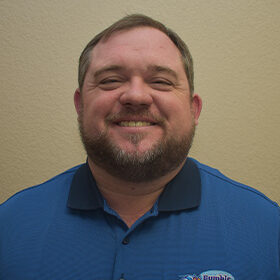As a homeowner, ensuring your heating, ventilation, and air conditioning (HVAC) system is maintained correctly is crucial. Ventilation is a key component of your HVAC system. Proper airflow ensures that your heating or cooling system operates efficiently, reducing utility bills and extending the system’s lifespan. Poor ventilation forces your system to work harder, leading to higher energy consumption and increased wear and tear.
Additionally, inadequate ventilation can cause uneven heating and cooling and inconsistent temperatures throughout your home. According to the U.S. Department of Energy, proper ventilation also improves indoor air quality by removing pollutants and excess moisture, which can contribute to mold growth and other health issues.
How HVAC Ventilation Works
Your forced air system uses return vents, supply vents, an air handler, ducts, and a blower to keep your home comfortable. Together, these components work to adjust the temperature and maintain air quality in your home.
Return Vents
Return vents bring air from your living spaces back into the HVAC system for reconditioning. Return vents are typically larger than supply vents because they handle the air for the entire home.
Unlike supply vents, you won’t feel airflow coming out of a return vent. Instead, these vents draw in air, helping to maintain balanced air pressure within the home. Properly functioning return vents are crucial for an effective and balanced HVAC system. If you are concerned that a return vent is not functioning correctly, you can hold a piece of paper around six inches from it. If the paper is pulled toward it, you know the vent is drawing in air.
Supply Vents
Supply vents are distributed throughout your home, typically in the walls, ceilings, or floors. These vents are covered by registers, which have adjustable dampers and flaps. These features allow you to control the airflow to specific rooms. No matter where they are positioned, their primary function remains the same: to deliver conditioned air to your living spaces.
Air Handlers
An air handler is a crucial component of your HVAC system that circulates air throughout your home using a blower and ductwork, akin to the lungs of your house. It plays a vital role in maintaining comfort by regulating the temperature of the air.
Air handlers can also accommodate additional air purification tools to enhance indoor air quality. You can add humidity control and air purification systems to your air handler, ensuring cleaner and healthier air.
The primary function of an air handler is to blow indoor air across a coil or heat exchanger. This process allows the air handler to heat or cool the air as needed, maintaining a comfortable indoor environment.
HVAC Filter
A HVAC air filter’s primary purpose is to prevent dust and debris from damaging the internal components of your heating and cooling system. However, they also play an essential role in maintaining indoor air quality by filtering out containments that would otherwise recirculate through your system and be breathed in by household members.
In air conditioners, the filter is typically located near the return air duct or the air handler, ensuring that incoming air is clean before it circulates through your home. For furnaces, the filter is usually between the return air duct and the blower fan, trapping contaminants before the air is heated and distributed.
Regularly changing or cleaning your HVAC filter is crucial for maintaining system efficiency and longevity since a clogged filter can reduce airflow, causing the system to work harder and increasing energy costs.
Ducts
Ducts are like your HVAC system’s circulatory system. They allow conditioned air to travel throughout your home. Each duct connects to a vent that releases air into specific rooms.
Faulty ductwork is a leading cause of HVAC inefficiency. The U.S. Department of Energy suggests that ductwork leaks can account for more than 30% of energy loss in a typical forced-air HVAC system, leading to higher utility bills and reduced system performance. If you find any leaks, you can call an HVAC technician to seal them up.
Blowers
Your blower is part of your air handler and is responsible for circulating conditioned air throughout your home. It consists of an electric motor and fan. This fan forces air into your duct system so that it can reach the vents in your rooms.
There are typically two main kinds of blowers. A single-speed blower functions at one speed and shuts off as soon as your set temperature is achieved. With a variable-speed motor, the blower can switch down to a lower speed to keep the air circulating in your home. You should consider getting a variable-speed blower for better energy efficiency and improved temperature control.
Ways to Maintain Your HVAC Ventilation
You can perform several tasks to ensure your HVAC system lasts as long as possible and keeps your home comfortable. Other maintenance will require the expertise of an HVAC professional.
Ensure Supply and Return Vents Are Not Blocked
It is essential to have adequate space around return and supply vents to ensure proper airflow in an HVAC system. Furniture, area rugs, and drapes can block your vents. Most return vents require 12 inches of clear space, but supply vents need 6 inches open around them.
Change HVAC Filters at Least Every Three Months
Experts recommend replacing your air filter at least every three months. However, you may need to change yours out more often due to factors like if you have pets, how often your system is running, and how many people live in your household. Many homeowners inspect their HVAC filters once a month so that they know when it is time to replace it.
Clean Your Vents
Dust and dirt can build up in your vents over time. To remove the covers, use a screwdriver. Then, use a vacuum with a brush attachment to clean out dust and debris inside the vent up to where your ductwork begins. You can clean the covers with hot water and dish soap. A bristle brush works well to remove caked-on grime.
Open Dampers
Sometimes, people close a register because they think it will help their HVAC systems become more efficient. In reality, this changes the air pressure and forces your HVAC system to work harder. In general, you don’t want to leave your registers closed. From time to time, check each room of your home to make sure no one has closed a register.
Schedule Regular Maintenance
You should call a HVAC professional for routine maintenance twice a year. Ideally, your first appointment should be to check out your air conditioner in the springtime before it gets hot. Then, you should call for furnace maintenance and repair in the fall before using your heating system. As part of our visit, we will ensure there is proper airflow to your heating and cooling system.
Contact the Pros
At Bumble Breeze, we have been serving the residents of Las Vegas and the surrounding areas since 2018. We install, maintain, and repair heating and cooling systems. In addition, we provide plumbing and indoor air quality services. Contact us today to schedule an appointment with one of our knowledge team members.


